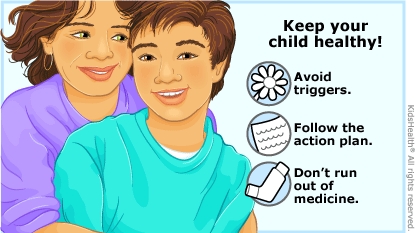Single maintenance and relief therapy (SMART) is used every day to prevent and treat asthma flare-ups with just one inhaler. The SMART inhaler is a combination inhaler. It contains a steroid to ease swelling in the airways and a long-acting, quick-relief bronchodilator that opens the airways.
The SMART combination inhaler is used every day. Your child can take extra doses as needed to treat asthma symptoms and to prevent symptoms from known triggers (for example, a cold, a change in the weather, or exercise).

Using the SMART combination inhaler:
- Your child needs to use their SMART combination inhaler every day as instructed by their health care provider. Skipping days can make the medicine not work as well.
- In addition to the everyday dose, your child should also use the SMART combination inhaler as instructed by their health care provider for:
- symptoms of an asthma flare-up, such as wheezing, coughing, or chest tightness
- their usual triggers, such as a cold (or other illness), weather change, or exercise
- Kids 6–12 years old should not take more than 8 puffs of the SMART combination inhaler in 24 hours.
- Kids over 12 years old should not take more than 12 puffs of the SMART combination inhaler in 24 hours.
- If your child has taken the maximum number of allowed puffs of the SMART combination inhaler and still has symptoms, they can take 2 puffs of a quick-relief inhaler (generic names include albuterol; brand names include Ventolin® and ProAir®). Then, call your health care provider to ask what to do next.
Important reminders:
- Your child should always use a spacer with their SMART combination inhaler.
- Have your child rinse out their mouth after taking their daily doses of the SMART combination inhaler. They do not need to rinse after rescue doses, as these are used less often.
- Your child should always have their SMART combination inhaler with them.
- Get refills on time so your child never runs out of asthma medicine.
- Help your child avoid asthma triggers when possible.
- Help your child follow their asthma action plan, if they have one.

- Your child has severe wheezing, is short of breath, or is breathing faster than usual.
- The skin between your child's ribs and neck pulls in tight during breathing.
- Your child's nostrils flare (open wide) with each breath.
Call 911 if your child is struggling to breathe, is too out of breath to talk or walk, or turns blue.

What are the benefits of SMART for asthma treatment? SMART helps kids have fewer flare-ups, ER visits, and hospitalizations. They also won't need to take oral steroids as often to treat their asthma. Using one SMART combination inhaler is also more convenient than using more than one inhaler.
Why should I call our health care provider if my child needs to use a quick-relief inhaler after taking the maximum number of doses of the SMART combination inhaler? It's important to call because:
- If your child still has symptoms after using the quick-relief inhaler, they may need other treatments to control their flare-up.
- Using quick-relief medicines more than occasionally can make your child more likely to have a severe asthma flare-up. If your child often needs the quick-relief medicine to control symptoms, your health care provider may want to change their treatment plan.




